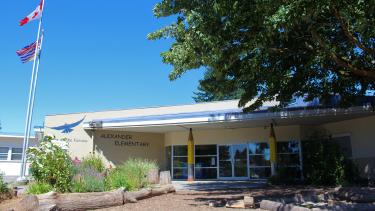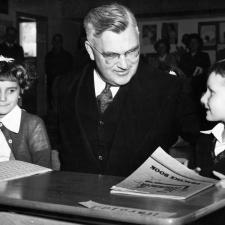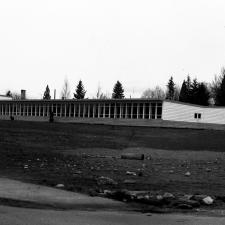
School Name History
Location
2250 Lobban Road, Abbotsford, BC
Opened
1951
The School
First known as Marshall-McKenzie Elementary, Alexander school was a one-room building with only Grade one students. It opened in 1951 as an annex to Abbotsford Elementary. It was not in the developed part of the town. One comment was, “Why build a school in a cow pasture?” In 1954, another room was added to accommodate Grade two. A third room was added in 1957, allowing Grade threes to join the school population. The addition of a fourth room in 1958 expanded the school to include Grades one to four. A gym followed in 1959. In 1962, it was declared to be a school, not an annex, and a principal was appointed. The school continued to grow and by 1975 it had eleven divisions from grades K-7. A major renovation was completed in 1994. Like many elementary schools, Alexander became a K-5 school in the early 2000s, when middle schools were established.
Origin of the Name
Where this name came from is unclear. When the school board met in 1951, three different people were discussed as the ones to be honoured by having the school named after them. All of them had Alexander as a first or last name. The three people were:
-
Alexander Peers, a pioneer teacher in Sumas
-
Viscount Alexander, the Governor General of Canada from 1946 to 1952
-
Alexander Hougen, the Reeve (the leader of the township council); he had been Reeve for eighteen years when the school opened.
The school trustee who suggested Alexander Peers at first could only remember the first name, so Peers was not well-known to him or to the rest of the board. Then another trustee suggested Alexander could be either Alexander Peers or Viscount Alexander. A third school trustee said, “It could also stand for Alexander Hougen, the Reeve of Sumas.” After the meeting, the members of the board would not say which person was being honoured, only that the school would be called Alexander Elementary.
Alexander Ingvald Hougen (1901-1986)
Alexander Hougen was born in Seattle in 1901. His parents came to Matsqui because a land company wanted settlers to buy its land. Its agent, Alex Cruikshank, advertised for settlers in U.S. newspapers written in the Scandinavian languages. Cruikshank chose eighteen Swedish and Norwegian families, and their new community became Matsqui Village. Hougen’s parents named their son Alexander in Cruikshank’s honour.
Alex became a dairy farmer, first on Matsqui Prairie and then on Vye Road on Sumas Prairie. In 1932, he was a police commissioner. He was also elected to be a councillor on the Sumas council. In 1933, he ran in the provincial election for the Liberal Party. He lost, but that same year he was elected Reeve of Sumas. He held that position for thirty-five years. He ran again for the Liberal Party in 1952 as “Your Farmer Candidate” but he lost once more.
During his thirty-five years as Reeve, one of his biggest challenges was in 1948. That year Matsqui Prairie was flooded. Hougen worked with the army and residents to prevent Sumas Prairie from being flooded too. Under his leadership, the roads of Sumas Prairie were paved, three bridges were built, and the development of farming was supported. As well as being on the council, Hougen was President of the Dairy Farmers Union and a founder of the Rotary Club of Abbotsford. In the 1960s, Hougen Park was named in honour of his long service to the community. In 1965, he retired as Reeve for health and family reasons. Still, he continued to serve as chairman of the board of management for the MSA Hospital, a position he held for ten years
Alexander Hougen died in 1986. His family established the Alex Hougen Memorial Fund to support the MSA Hospital.
Harold, Viscount Alexander of Tunis (1891-1969)
Harold Rupert Leofric George Alexander was born in London in 1891. He was the son of the *Earl of Caledon. He was educated at a private school, then went to a military college to train as an army officer. He fought in World War I. For his actions in the war, he was awarded the Military Cross, the Distinguished Service Order and the Legion of Honour.
In World War II, he was the Major General of the First Division. He was promoted to Field Marshall in 1945 when he and his troops captured the city of Tunis in Tunisia, Africa. In 1946 he was given the title of *Viscount Alexander of Tunis. He was also named a *Knight of the Garter.
In the same year, King George VI appointed him Governor General of Canada. As Governor General, Viscount Alexander represented the King in Canada. He saw himself as a link between the King and Canadians so, as he travelled the country, he talked with people from all walks of life. His friendliness and ability to communicate made him popular with Canadians.
He liked fishing, golfing, hockey, and rugby. He was also a painter. He had an art studio at Rideau Hall (the official house of the Governor General in Ottawa) and organized art classes at the National Gallery. He encouraged education in Canada. Many Canadian universities and some American universities gave him honorary degrees.
In 1952, he returned to London to become a member of the British government. Because he was considered one of Britain’s greatest military leaders, he was appointed the Minister of Defence. He was given the titles of the first Earl Alexander of Tunis and *Baron Rideau of Ottawa. He retired from the government in 1959. For a time, he then served as *Constable of the Tower of London, an honour given to a retired Field Marshall or General for service to the country. Viscount Alexander died in London in 1969.
The Abbotsford School District graciously acknowledges the Abbotsford Retired Teachers Association for collecting the histories and stories of our schools as part of their "What's in a name?" 50th-anniversary project.
Images courtesy of The Reach P4454, P22759

